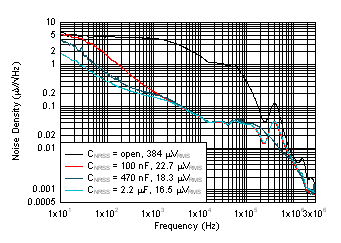SLVAEW7 September 2020 ADC12DJ5200RF , LMK00304 , LMK04828 , LMX2594 , TPS62912 , TPS62913
1.1.2 Power Supply Requirements for Wideband RF PLL and Clocks
On the ADC12DJ5200 evaluation module, an RF PLL is used as a frequency synthesizer for clocking the ADC. Similar to high speed ADCs, higher frequencies command larger supply currents. At the same time, higher frequencies require lower clock jitter and therefore lower phase noise. Phase noise is directly impacted by the power supply noise and ripple. Since the LMX is powered from a 3.3-V supply rail, the PSRR is measured from the 3.3-V rail to the spurs of the output specturm. The LMX PSRR has a low-pass behavior with increasing attenuation at frequencies above the PLL loop bandwidth. The most sensitive frequency range for supply noise is before and around the PLL corner frequency, and heavily depends on the PLL filter characteristics. At low frequencies the noise is dominated by the external oscillator noise. Therefore, it is key to have a low-noise DC-DC converter design with <20 μVRMS noise (100 Hz to 100 kHz) and low spectral noise density of ~0.1 uV/√(Hz) before the PLL corner frequency in the range of 1kHz to 100kHz to achieve clock jitter of 100 fs and lower. The performance of the TPS62913 is shown in Figure 1-3.
 Figure 1-3 TPS62913 Output Noise Density vs Frequency for 12Vin to 3.3Vout at
2.2MHz
Figure 1-3 TPS62913 Output Noise Density vs Frequency for 12Vin to 3.3Vout at
2.2MHzThe TPS62913 has been designed specifically for low noise with the addition of an external noise reduction filter cap, which also provides the means to adjust the softstart time. Using a 470 nF CNR/SS cap provide the noise performance desired and a 5 ms softstart time.